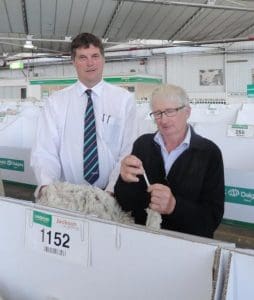
Landmark Jackson of Geelong’s Ted Wilson, left, with ultrafine wool grower David Rowbottom.
ULTRAFINE wool producers David and Susan Rowbottom have sold more White Suffolk than Merino rams in recent years.
And several of the couple’s former Merino ram clients now buy White Suffolks to put over their ultrafine ewes, but the recent lift in wool prices is giving them renewed hope.
Wool prices are finally moving in the right direction for their Rowensville Ultrafine flock, which has been renowned for producing some of the finest wool in the world.
The Rowbottoms have won the prestigious Ermenegildo Zegna Vellus Aureum wool award for the past three years, winning the competition last year with a 9.9 micron fleece and in 2015 with a 10.1 micron fleece.
They farm at St Helens in south-west Victoria and last week sold 22 bales of paddock-grown 13.3-14.8 micron fleece wool through Landmark Jackson of Geelong, with most making 1500-1600c/kg greasy. The oddments were sold late last year.
“It’s way better than it was last year, but it is still a long way behind our better years,” David said.
“We run the same amount of Merinos year-in year-out and last year our wool cheque was only a bit over half what it was in the better years and this year I suppose it is a shade over two thirds what it has been in the better years.
“It was definitely a good improvement,” he said.
The fleece wool averaged 1575c/kg greasy and the finest one-bale line 13.3 microns sold for 2000c/kg and yielded 71.8 percent with a tensile strength of 27Newtons/kilotex.
“This is one of our worst years in terms of tensile strength.”
Unlike superfine wool producers, many of which now sell their best wool under contract to Italian processors, the Rowbottoms have been unable to secure contracts for their paddock-grown wool, and it has been difficult to find a buyer for the shedded wool at prices above the cost of production.
“We are too fine (for the contracts).
“They are not out there for ultrafine wool.”
Traditionally most of the Rowbottoms’ clip has been bought by Italian processors for fine suiting manufacture, but in Melbourne last week, two Chinese companies Tianyu and Zhong Long International bought the wool, outbidding European interests.
“That is certainly a change for our wool, we’ve never had that happen before.
“I can’t even remember them buying one line,” he said.
“It was a surprise to us that the Chinese outbid the Italians on it.”
Ultrafine rams sales ‘almost non-existent’
David said sales of his ultrafine Rowensville Merino rams are almost non-existent.
“We’ve sold five Merino rams this year, compared to about 70 when it was at its peak.
“And the White Suffolk rams sold out and we are now knocking back people asking for them,” he said.
“A lot of our Merino rams clients have retired and those that haven’t have turned over to fat lambs and we are selling White Suffolk rams to a number of them.
“To a degree the White Suffolks are subsidising our Merinos at the moment,” David said.
“Merino wool was good to us for years, but now it is the other way around and we are not getting anywhere near what we can make out of the fat lambs.”
David said he was hopeful that because so many producers had gone out of ultrafine wool production that demand for the remaining supply would “kick-in” and prices will come good again.
“We’re continuing, it’s what I want to do.
“This year is certainly a step in the right direction, but for our type of wool it has a long way to go,” he said.
Although the top price this year was a 25pc increase on a similar bale last year, David said ultrafine wool prices need to improve.
“To do really well we need a 50pc rise above present wool prices.
“In its heyday, we were selling a lot of lines for 2100-2200c/kg greasy,” David said.
The Rowbottoms are one of only four shedded wool producers in Australia, compared to more than 30 about 20 years ago.
Little price difference between 14 and 17.5 micron wool
Landmark Jackson of Geelong superfine specialist Ted Wilson said there is now a relatively small price differential between 17.5 micron wool and 14.5 micron, which meant the Rowbottom clip represented a reasonable buying opportunity for the Chinese buyers.
“The last time 17.5 micron wool was at this level in 2011, 14 micron wool would have been in excess of 1000 cents clean above it at probably around 3000c/kg greasy or more.”
Most 14-14.5 micron wool in the market was making 1600-1700c/kg greasy and could be blended with cashmere or with 16-17 micron wool, he said.
“The whole market in recent months has been driven by Chinese demand, not so much by the Europeans.
“There are still superfines and ultrafines going into Europe, for sure, but there hasn’t to my knowledge been any big surge in interest for these wools in Europe.”



HAVE YOUR SAY